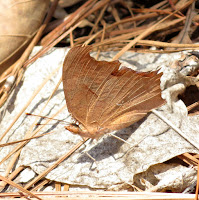 |
| Question mark butterfly |
The interesting news this year is that I’ve seen a few butterflies (and moths) that I haven’t seen before. I attribute these discoveries to 1) paying attention, 2) serendipity (being outside at the right time), and 3) using the right host plant. A fourth reason might be having more floral resources: for example, I think the bountiful April blooms of golden ragwort (Packera aurea) helped steer two Monarch females to my yard in April (where they laid eggs!).
 |
| Question Mark butterfly |
The second new one showed up in May: a Gray Hairstreak. Hairstreaks are small butterflies, and the Red-banded one is very common here. Last year I also found a Coral Hairstreak. I’m sure that there are other species out there but they are small, fast, and skittish.
By June I was seeing plenty of Eastern Tiger Swallowtails, clearwing hawkmoths, Silver-spotted skippers, American Ladies, and even a Spicebush Swallowtail. In mid-June, I was delighted when a Pipevine Swallowtail came through but alas it was either not a female or it couldn’t find my pipevine (Aristolochia tomentosa). Throughout the summer I would also see similar large dark butterflies like the Red-spotted purple and the dark form of the female Tiger Swallowtail.
August brought an abundance of Carolina Satyr butterflies and I was able to chase down a pair who was too busy mating to escape my camera. This is a small, dark-colored species that prefers to hang out in the forest understory until it’s time to lay eggs on grass relatives and I often startle them just by walking by wherever they were resting.
Mid-August had an exciting surprise when a Zebra Longwing showed up in the backyard. This is considered a bit of an uncommon visitor here. I was hoping it was a female who would lay eggs on my passionvines, but I don’t know if that happened. The butterfly was gone the next day.
 |
| Carolina Satyr couple |
 |
| Zebra longwing |
Mid-August had an exciting surprise when a Zebra Longwing showed up in the backyard. This is considered a bit of an uncommon visitor here. I was hoping it was a female who would lay eggs on my passionvines, but I don’t know if that happened. The butterfly was gone the next day.
Silvery Checkerspot butterflies joined their smaller lookalikes the Pearl Crescents in the garden while the Tiger Swallowtails increased in numbers. The backyard, which has flowers that are protected from the deer, became the hotspot. At the end of August, two more new ones showed up: a Northern Pearly Eye and a Red Admiral. The Northern Pearly Eye was only around for a few minutes; it doesn’t usually nectar on flowers, choosing instead to get nourishment from dung, fungi, carrion, and sap.
I believe the appearance of the Red Admiral is thanks to the addition of its host plant. I ordered seeds for false nettle and scattered them around in a couple places. I never saw the caterpillars but I could tell that something was feeding on the plant. The adult that I saw was so fresh that I believe it might have grown up in my yard. Sometimes you just have to plan for butterflies!
In early September, one of my roadside Fritillary collections emerged as a Variegated Fritillary; I knew it would be because the chrysalis looks different. What a beautiful one! That same day I caught a glance of something different and snapped a couple of pictures of an American Snout before it took off. I knew this species must be around because there are some large hackberries (Celtis spp.) nearby.
 |
| Variegated Fritillary |
 |
| American Snout |
I’ll wrap up this year’s discoveries with two new caterpillars that I found on redbud (Cercis canadensis). August is a good time for caterpillar searching. This year I found a bunch of white flannel moths and several American dagger moth caterpillars, and just this week, I found an imperial moth caterpillar in the woods on sweetgum.
 |
| Imperial moth |
Gardening for Butterflies (review of book by The Xerces Society)
Native Plants for Butterfly and Pollinator Gardens (including downloadable plant list files for Spring, Summer, Fall)




Enjoyed your article, Ellen. Great information and pictures. Very interesting!
ReplyDeleteI've been waiting for this one as I knew your new nickname, Cat Momma, would lead us here. Will you share your numbers of raised in a cage count?
ReplyDeleteFun, you're having fun, and it comes through, in every sentence!
ReplyDeleteI've seen so many zebra longwings this year! Ours seem to have a creamy colored stripe rather than white.
ReplyDeleteFun article, Ellen! and full of things to dream about discovering next butterfly season. Thanks.��
ReplyDeleteWe have seen all the butterflies in our garden too...except the zebra one, we have seen that at Stone Mountain Park, along the trails. Oh, and the Carolina one, don't think we have it, or else, haven't seen it. We have really enjoyed the butterflies! We had a few Monarchs recently, and I fell all over myself trying to get a photo!
ReplyDelete